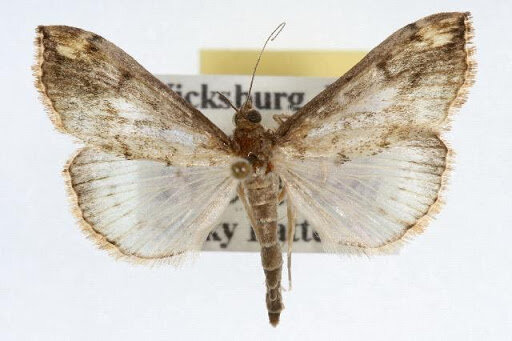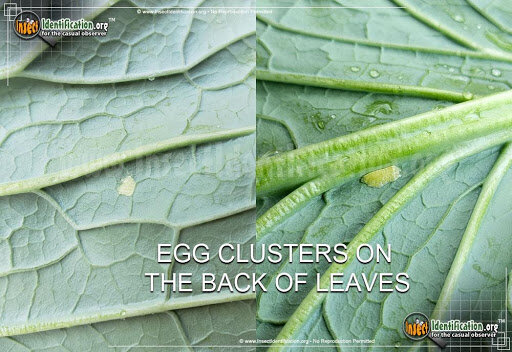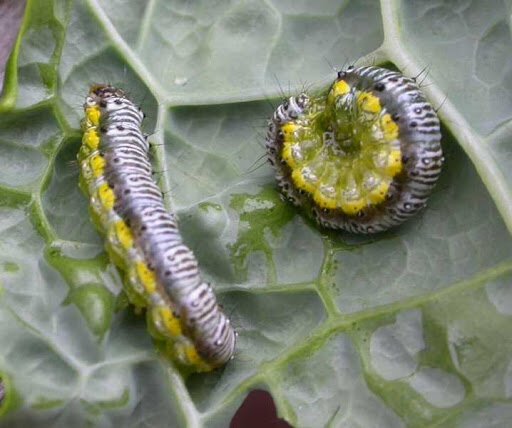Brassica Pests: Identification & Solutions
By Rebecca Halcomb, Leadership in Urban Agriculture Internship, Fall II 2020
Part 1: Identification
I had a lot of pest issues this year, but the ones that did the most damage were the pests that took out my brassica crops of collard greens, kale, broccoli, and cabbage.
I had hand-removed a few caterpillars, but less than a week later, this was what I found when I walked out to my garden on August 14th:
These had been the largest most beautiful collard greens I’d ever grown, and were now covered in caterpillars I didn’t recognize:
When I came to intern at Urban Harvest STL, I noticed one of the same pests I had encountered on my brassicas, and learned it was called a cabbage looper. I originally thought it was just the cabbage looper in various phases that I was dealing with in my garden, but when I started researching and looked back at my garden pictures, I noticed that the caterpillars on my collard greens and kale were different from the caterpillars on my broccoli, so I was dealing with multiple pests. I decided to research both pests I had issues with, and then I also ended up finding info on another cabbageworm called the imported cabbageworm. That caterpillar looked very similar to the cabbage looper, but the butterfly was different, so I wanted to address those as well.
First let’s look at how to identify all 3 brassica-eating culprits.
CABBAGE LOOPER ID
Here’s a picture of the cabbage looper moth to look out for.
It will lay eggs that look like this.
As a caterpillar, it will look like this.
IMPORTED CABBAGE WORM ID
The imported cabbage white butterfly to watch out for, that produces the green imported cabbage worm, looks very similar to the cabbage looper caterpillar.
Their eggs are also tiny and white, but more cone-shaped.
This is what the green cabbage worm looks like. It’s slightly fatter, doesn’t make the distinctive loop with its back when it crawls, and has a faint yellow stripe down the back.
CROSS-STRIPED CABBAGEWORM ID
It took me awhile to find the name for the striped caterpillar that skeletonized my collards so badly, but I finally found my worst culprit: the cross-striped cabbageworm.
Here are some pictures of the moth to look out for, the eggs they will lay, and a better close up of the caterpillar:




The moral of this is that pest ID can sometimes be tricky, but it’s definitely worth it so you know what you’re dealing with, and the best way to manage the pest so that you can harvest as much high quality crop as possible. In Part 2, we’ll examine how to thwart our brassica foes.
Part 2: Solutions
Once you have identified which pest is attacking your brassica crops, then you can work towards managing the problem. In this case, most of the treatments are very similar for all 3 kinds of caterpillars. There are a few specific solutions, but I’ll note those below:
Row Covers: Cover brassica crops with floating row cover or screen cover from when you plant to when you harvest to keep the butterflies and moths off. You should still regularly inspect though. You can also use pantyhose on cabbage heads, and those will grow with the plant and let enough air, sunlight, and moisture in.
Hand-picking: It can be time-consuming and they can be easy to miss, especially the 2 green species. They like to hide on the underside of the leaves, and blend in with the leaf veins. It’s actually much easier to see their dark green frass (poop) than it is to see them. You can drown them in soapy water once you pick them off.
Use Predators: Hang birdhouses in or near the garden or let the chickens into the garden temporarily once the plants are hardy enough, and they will eat the caterpillars for you.
Plant Tolerant Varieties: Some examples of green cabbage varieties that are a more resistant are Green Winter, Savoy, and Savoy Chieftain. You can also try planting red-leafed varieties of cabbage and kohlrabi, which are less desirable because of lack of camouflage for the 2 green caterpillars.
Attract Beneficial Insects: You can either buy them directly, or plant a good selection of flowers and flowering herbs around your brassicas to attract the beneficial insects that will prey on your pests. Some plants to use for this would be parsley, dill, fennel, coriander, and sweet alyssum. (Be careful if cross-striped cabbageworms are your culprit, because they also destroy parsley.) These flowers will attract parasitic wasps, paper wasps, yellow jackets, and shield bugs. Parasitic wasps will lay their white cocoons on the caterpillars’ backs. Leave the cocoons alone to kill off your pest, and then you’ll have a new generation of parasitic wasps for later waves of pests. If you don’t want to rely on your flowers to attract them, you can purchase trichogramma wasps, and release them to destroy the pests’ eggs.
Use Companion Planting: Interplant companion plants among your brassicas that repel the butterflies/moths, like aromatic herbs such as lemon balm, sage, oregano, borage, hyssop, dill, and rosemary, or high blossom flowers like tall marigolds or calendula.
Use Trap Crops: For Loopers, plant celery or amaranth. For Cabbage Worms, plant nasturtiums or mustard. The butterflies/moths will lay their eggs on those crops first, and then once you see the pests, you can dispose of the trap crop to get rid of them.
Frequent Harvesting: For the cut and come again crops, such as Kale and Collard Greens, harvest the leaves more frequently to interrupt the pest life cycle.
Pheromones: Use pheromone traps to monitor and control their populations.
Biological Pesticides: Spray with BT (Bacillus thuringiensis). It’s a natural bacterium that kills caterpillars and worms. BTK sprays in particular do not harm honey bees or birds and are safe to use around pets and children. One source said to spray for Loopers early in the season as a preventative, and then use again for later waves. For cabbage worms, it said to spray every 2 weeks until they get under control. Another source said that one treatment in late summer approximately 2 weeks before harvest can greatly improve your crop quality. You’ll have to reapply after rain though.
Diatomaceous Earth (DE): DE is a very fine powder that when sprinkled can cut up any soft-bodied insect that comes into contact with it. This also has to be reapplied after rain.
Insecticidal Soap: Spray with Organic Insecticidal soap, but this also has to be reapplied after the rain.
Other Repellent Sprays: For Loopers, you can spray the crops with liquefied and strained cabbage loopers or hot pepper spray.
Seasonal Clean Up: For the cabbage worms, do a thorough fall clean-up of old plants and debris, since the butterflies like to overwinter there. (The white cabbage butterfly usually shows up early in the spring because they overwinter instead of migrate.)
Use Decoys: This method is a little experimental, but supposedly the Cabbage Butterflies are territorial and don’t like to lay their eggs if they think another female has already claimed your plants. So you can make white butterfly-shaped decoys out of plastic or another durable material, and put them by your garden plants. Make them 2 inches wide, and with 2 black spots on the upper wing. I think I’m going to repurpose some milk cartons and give it a try. Here’s the link to a template: http://goodseedco.net/blog/posts/cabbage-butterfly-decoy
RESOURCES
University Extension websites have compiled a lot of helpful info on garden pests:
University of Minnesota Extension has pictures of the cabbage looper eggs, which are very tiny white round dots, about the size of a pinhead. There are also pictures of the dark green pellets that they excrete: https://www.vegedge.umn.edu/pest-profiles/pests/cabbage-looper
UMass and UConn Extensions have some good info on the Cross-Striped Cabbage Worm: https://ag.umass.edu/vegetable/fact-sheets/cross-striped-cabbage-worm
http://ipm.uconn.edu/documents/raw2/html/579.php?display=print
Non-Extension Resources:
This website has pictures of the various Cabbage Looper stages, their defining characteristics for accurate ID, as well as a full list of the plants they feed on, and their egg laying schedule: http://www.idtools.org/id/citrus/pests/factsheet.php?name=Cabbage+looper
This website notes the difference between the Cabbage looper and Imported cabbageworms: https://www.growveg.com/pests/us-and-canada/cabbage-worm-cabbageworm-cabbage-looper/
Some helpful info that compare the 2 cabbageworms: https://theberkshireedge.com/natures-turn-unwelcome-cabbage-white-butterflies-and-dreaded-cross-striped-cabbage-moths/
This was a very beneficial website that gave some practical tips on controlling cabbage loopers: https://www.planetnatural.com/pest-problem-solver/garden-pests/cabbage-looper-control/
Missouri Botanical Garden has info and tips:
Imported cabbageworm: https://www.missouribotanicalgarden.org/gardens-gardening/your-garden/help-for-the-home-gardener/advice-tips-resources/pests-and-problems/insects/caterpillars/imported-cabbageworm.aspx
Other Sources:








